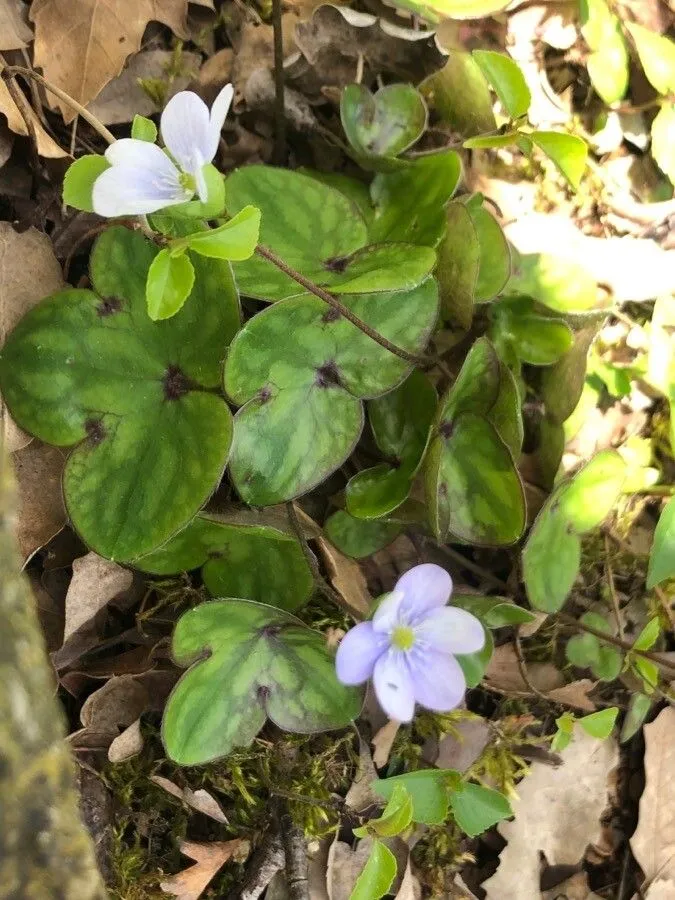
Author: Schreb.
Bibliography: Spic. Fl. Lips.: 39 (1771)
Year: 1771
Status: accepted
Rank: species
Genus: Hepatica
Vegetable: False
Observations: Europe to Siberia
Hepatica, scientifically known as Hepatica nobilis, is a charming perennial herb that has captivated botanists and garden enthusiasts alike. First described in Schreb’s “Spic. Fl. Lips.” in 1771, this plant has proven to be a resilient and enduring presence across its native range, which stretches from Europe to Siberia.
Belonging to the Ranunculaceae family, Hepatica exhibits a unique blend of beauty and robustness. It thrives in shaded, woodland environments where it carpets the forest floor with its attractive, trilobed leaves. These leaves persist year-round, withstanding the cold of winter and providing a touch of green even when many other plants have succumbed to the frost.
Hepatica’s blossoms are one of its most defining features, typically emerging in early spring. Each flower boasts a delicate array of blue, purple, pink, or white petals, creating a colorful display that heralds the arrival of warmer weather. The flowers are supported on slender stems that rise above the low-growing foliage, ensuring that the blooms are easily visible and accessible to pollinators.
Despite its delicate appearance, Hepatica is remarkably hardy. It is well adapted to temperate climates and can thrive in a variety of soil conditions, provided they are well-drained. This resilience makes it a popular choice for rock gardens and woodland gardens, where it can form beautiful, natural-looking colonies.
In addition to its ornamental value, Hepatica has a history of use in traditional medicine, believed to possess various healing properties. However, it’s important to approach such uses with caution and to rely on modern scientific evidence and guidance.
Overall, Hepatica nobilis is a testament to nature’s ability to combine beauty and strength, making it a beloved part of the flora in regions from Europe to Siberia. As gardeners and nature enthusiasts look for ways to incorporate hardy yet beautiful plants into their landscapes, Hepatica stands out as an excellent choice.
Dan: blå anemone
Deu: gewöhnliches leberblümchen, leberblümchen
Eng: hepatica, liverleaf
Swe: blåsippa, sinivuokko
Nno: blåveis
Nob: blåveis
Fin: sinivuokko
Cym: dail yr afu, deilen yr afu
En: Hepatica, Liverleaf, Roundlobe hepatica, American liverleaf, Common hepatica, Kidneywort, Liverwort, Liverwort-leaf, Pennywort, Round-lobe hepatica
Ar: شقار كبدي
Be: Пералеска высакародная
Bg: Гълъбови очички
Ca: Herba fetgera
Zh: 三角草
Cs: Jaterník podléška, Jaterník podléšťka, Jaterník trojlaločný
Da: Blå Anemone
Nl: Leverbloempje, Leverbloem
Et: Harilik sinilill, Keltsalill, Külmalill, Lumekannike, Lumelill, Maksalehed, Metsamirt, Sapihein, Sinilill, Siniülane, Surmalill
Fi: Sinivuokko, Lehtosinivuokko
Fr: Anémone d’Amérique, Anémone hépatique, Hépatique d’Amérique, Hépatique noble, Hépatique à trois lobes
De: Dreilappiges Leberblümchen, Leberblümchen, Leberblümerl (Bavarian), Gewöhnliches Leberblümchen, Leberblume
Hu: Nemes májvirág
It: Erba trinit√†, Erba della trinità, Erba trinità
Lv: Zilā vizbulīte
Lt: Triskiautė žibuoklė
Ml: ഹെപ്പറ്റിക്ക നൊബിലിസ്
Se: Alitnásti
No: Blåveis
Fa: جگرواش معمولی
Pl: Przylaszczka pospolita
Ru: Перелеска, Печеночница благородная, Печёночница благородная, Печёночница обыкновенная
Sk: Pečeňovník trojlaločný
Es: Navadni jetrnik, Anémone de flor cerúlea, Epática, Hepática noble, Hepática, Hierba de la Trinidad, Hierba del hígado, Trifolio aureo, Trifolio áureo, Trébol dorado, Viola de llop, Yerba de la Trinidad, Yerba del hígado
Sv: Blåsippa, Liten blåsippa
Uk: Печіночниця благородна, Печіночниця звичайна
Cy: Deilen yr afu
Taken Mar 26, 2022 by NP7 (cc-by-sa)
Taken Apr 17, 2022 by Alois Landgesell (cc-by-sa)
Taken Mar 28, 2022 by Samuel , (cc-by-sa)
Taken Jul 11, 2022 by Nymphaea Notschaele (cc-by-sa)
Taken May 2, 2021 by Frank Milius (cc-by-sa)
Taken Mar 26, 2021 by Modsol (cc-by-sa)
Taken Apr 9, 2021 by gramona97 (cc-by-sa)
Taken Apr 18, 2021 by K. Svabek (cc-by-sa)
Taken Mar 28, 2009 by Andrzej Pasierbinski (cc-by-sa)
Taken Apr 14, 2022 by M Petra (cc-by-sa)
Taken Apr 13, 2022 by Diego Alex (cc-by-sa)
Taken Apr 16, 2021 by Daniel Bäck (cc-by-sa)
© copyright of the Board of Trustees of the Royal Botanic Gardens, Kew.
© copyright of the Board of Trustees of the Royal Botanic Gardens, Kew.
© copyright of the Board of Trustees of the Royal Botanic Gardens, Kew.
Growth habit: Forb/herb
Ph maximum: 7.5
Ph minimum: 7.0
Light: 4
Atmospheric humidity: 5
Bloom months: [‘mar’, ‘apr’, ‘may’]
Soil nutriments: 5
Family: Myrtaceae Author: (F.Muell.) K.D.Hill & L.A.S.Johnson Bibliography: Telopea 6: 402 (1995) Year: 1995 Status:…
Family: Rubiaceae Author: Pierre ex A.Froehner Bibliography: Notizbl. Bot. Gart. Berlin-Dahlem 1: 237 (1897) Year:…
Family: Sapindaceae Author: Koidz. Bibliography: J. Coll. Sci. Imp. Univ. Tokyo 32(1): 38 (1911) Year:…
Family: Asteraceae Author: A.Gray Bibliography: Pacif. Railr. Rep.: 107 (1857) Year: 1857 Status: accepted Rank:…
Family: Fabaceae Author: Medik. Bibliography: Vorles. Churpfälz. Phys.-Ökon. Ges. 2: 398 (1787) Year: 1787 Status:…
Family: Aspleniaceae Author: (Cav.) Alston Bibliography: Bull. Misc. Inform. Kew 1932: 309 (1932) Year: 1932…